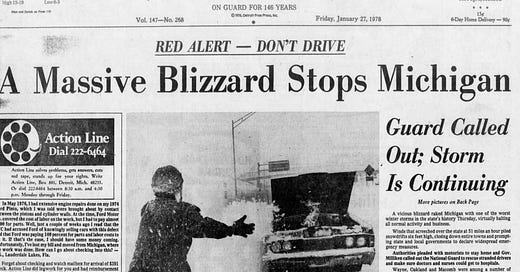Remembering the Blizzard of 1978: A Storm for the Ages
The Blizzard of 1978 brought West Michigan to a standstill, leaving 15-foot drifts and a community united in resilience. Discover the stories of this historic storm.
Forty-five years ago, West Michigan was engulfed by what many still call the "Storm of the Century." The Blizzard of 1978 is more than just a weather event; it's a shared memory for those who lived through it. The stories, the struggles, and the sheer volume of snow left an indelible mark on the community.
The Beginning of the Storm
By early afternoon on January 26, 1978, a state of emergency was declared across almost all of the New Center 8 viewing area. This storm was unlike any other, catching residents off guard with its intensity. The blizzard hit from Portage to Nashville, Three Rivers to Holland, affecting every corner of West Michigan.
Bill Steffen: The Face of the Blizzard
Among the many voices covering the storm, Bill Steffen became a household name. His continuous updates during the blizzard transformed him from a local meteorologist to a community celebrity. He recalls the moment he realized how significant the storm would be. Initially forecasting 6 to 10 inches of snow, he felt he might have overdone it. “Ten inches in 24 hours? That’s huge,” he thought. Little did he know, the storm would deliver much more.
The Impact on Healthcare
As the snow fell heavily on the night of January 25, healthcare professionals faced immense challenges. Foreign Horseman, a nurse at Lakeview General Hospital in Battle Creek, left for work hoping to return home the next morning. Instead, it took her four days to make it back. Hospitals across Grand Rapids struggled, with officials calling for four-wheel drive vehicles to transport staff. Emergency medical services were hampered, relying on military vehicles to reach those in need.
Transportation Chaos
The blizzard rendered over 100,000 vehicles abandoned on Michigan roads. Many motorists found refuge at local hospitals and military bases, while snowmobiles became a crucial mode of transportation. State police urged residents to stay off the roads, warning that anyone driving without a good reason could face arrest.
Life at Home
For those hunkered down at home, entertainment was scarce. With no cell phones or computers, many turned to television for updates. Bill Steffen became a lifeline for information. “If you were snowed in, you watched me on TV,” he shared. The community relied on his updates, as the storm continued to wreak havoc.
Snow Drifts and Recovery
As the storm raged on, the snow drifts grew to astonishing heights—some reaching 15 feet. The recovery was slow, with residents struggling to clear their driveways and roads. Bruce Smith, a meteorologist with the National Weather Service, reflected on his childhood experiences in northern Michigan, which fueled his passion for meteorology. He noted that while the December blizzard of 2022 had similar snowfall, the 1978 event still stands out due to its overall impact.
Lessons Learned
Fast forward 45 years, and Bruce believes that while a storm like the Blizzard of 1978 could happen again, advancements in forecasting and emergency response would make a significant difference. “We could see a storm with those types of impacts again,” he said. “Back then, we had only a few days’ notice; now we can predict storms a week in advance.”
A Moment to Remember
Despite the chaos and challenges, many who experienced the Blizzard of 1978 look back fondly on the memories. “I think I’m very glad I got to experience it,” one resident reflected. It was a moment in time that shaped the community and forged connections that remain strong to this day.
Continuing the Conversation
The Blizzard of 1978 remains a topic of conversation among those who lived through it. The stories, the challenges, and the communal spirit that emerged from the storm serve as a reminder of resilience in the face of nature's fury. If you have memories to share or want to see more about this historic event, check out this article on lake effect snow or learn more about the Blizzard of 1978.





